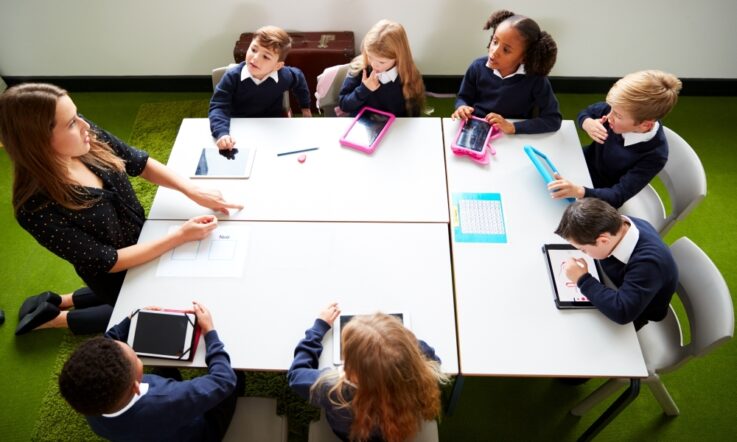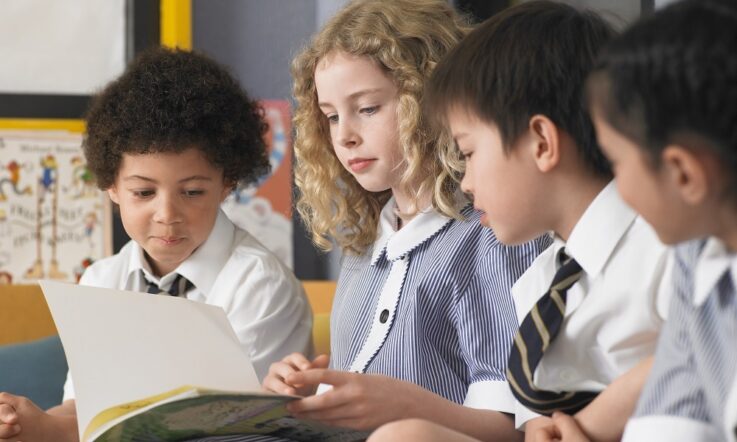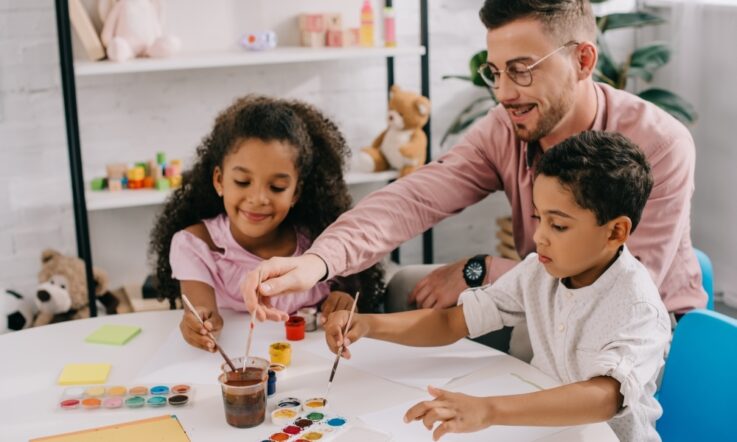This podcast from Teacher is supported by Bank First – the bank built by teachers for teachers.
Thanks for tuning in to this episode of Teacher Staffroom, where we catch you up on the latest evidence, insight, and action in education. I'm Dominique Russell.
Augmented Reality, or AR, is an immersive tool that allows students to engage in learning in new and exciting ways. But what are the specific educational benefits of this technology, and what is the teacher’s role? This month on Teacher, we shared a few stories on the topic of Augmented Reality and technology in education, which I’m going to share with you in this episode.
And, like all episodes of Teacher Staffroom, I’ll be sharing some other highlights from content we’ve published during the month, and I’ll also be posing some questions throughout the podcast, so feel free to pause the audio as you go, gather some colleagues, and discuss together how these stories might be relevant to your school context. Let's jump in.
We’ve heard about the use of AR in lessons with secondary school students, but what about in the primary years? In the first 2 articles of a 3-part reader submission, Dr Susan O’Donnell and Adrian Rayner give an update on the work of the VR Learning & Design Hub, which has been exploring the benefits of AR in the classroom.
Susan and Adrian have been keeping us up to date with the work of the VR Learning & Design Hub since 2021 and, so far, have shared some of the exciting learning possibilities for students and teachers with Virtual Reality. In their first article of this latest series, they give an explanation of what AR is, how it differs from VR, and some of the educational benefits for students – for example, it improves levels of participation and engagement, student perspective, imagination and cognitive ability and is suitable for a wide range of ages, learning styles and abilities.
They also discuss the teacher’s role in this article. Here’s what they had to say:
… to maximise the benefits of AR requires the commitment, openness and willingness of skilled teachers. It is they who will design the learning tasks integral to a guided inquiry pedagogical approach. They make the judgements about the inclusion of AR in their learning and teaching programs … Teachers, therefore, should reasonably expect that they are provided with training in the effective use of AR.
So, this brings me to a question for you to reflect on. How could integrating the use of AR into learning activities be used to complement a unit of work you have coming up? What are the barriers to making this happen and how could you work with your colleagues and wider networks to overcome these?
In the second article, Susan and Adrian take us through some of their recent work on AR which involves the use of AR in the primary years. They share that the VR Learning & Design Hub has developed an AR module based on the Endeavour for use by F-6 students in Queensland Department of Education schools.
On why they found it important to look at AR in the primary years, the authors had this to say:
The Hub’s decision to begin developing modules for primary students was, and is, based on a conviction that effective use of immersive technologies enhances teaching and learning, improving student achievement and developing digitally competent and confident young people for a technological world that is continually changing.
You can read the full article at our website, teachermagazine.com. And, stay tuned for Part 3 which will be published soon. The easiest way to make sure you don’t miss it is to sign up to our free weekly Teacher bulletin email, which you can do by following the prompts on our website.
Coming up, we’ll take a look at how digital school partnerships are enhancing learning for students. But first, here’s a quick message from our sponsor.
Busy living life to the fullest? With Bank First's term deposit, you can make your money work even harder while you keep on doing the things you love. Visit bankfirst.com.au to find out more about our amazing term deposit offers. Bank First. Caring for those who care for the community is just what we do. Bank First is the product issuer, AFSL/ ACL 240 960. Terms and Conditions apply, FSG and relevant TMD available online.
An ongoing series we have on Teacher is Teacher’s Bookshelf. The most recent instalment shares an extract from Dr Donna Cross and Dr Leanne Lester’s book, Leading Improvement in School Community Wellbeing. The extract discusses the role of ‘wellbeing champions’ in a school setting, and the 4 key elements school leaders need to prioritise when it comes to staff wellbeing.
The 4 key elements are: quality induction and sufficient professional learning, clearly defined roles, role status equivalence, and a proactive focus on wellbeing. You can read the full extract at our website to gain an understanding of each of these 4 elements in detail, but now I’d like to highlight this final point from the extract:
Wellbeing leaders are often involved in liaising with police, social workers and other family and community services when students require support or help. This work can be invisible to other staff (unless things go wrong). This intensity means leaders of wellbeing may have limited time to be proactive, relative to providing support. By ensuring the role is adequately recognised and resourced, school leaders can facilitate equitable wellbeing policies and practices to optimise every student’s wellbeing, including those with high needs, and they can ensure wellbeing efforts are both proactive (wellbeing protection, promotion and prevention of problems) and reactive.
That quote there brings me to a question for you to think about. As a school leader, think about the wellbeing roles in your own school: Are they adequately recognised and resourced? Are these staff members offered specialist training to care for their own wellbeing? Are they trained in ways to systematically implement universal whole-school approaches to promote student wellbeing?
Another piece of wellbeing-related content I’d like to share with you in today’s episode is an article from Year 7-10 Humanities teacher Andreas Katsanos. In the piece, titled Fostering strong relationships and a positive learning environment, he shares a step-by-step process he undertook to refine his own classroom practice in these 2 areas while at Beaconhills College in Melbourne.
At a glance, the 5-step process involves recognising and rewarding positive behaviour; taking the time each week or fortnight to choose 5 students who had done well and to contact their families by email or phone; acknowledging students that have improved; checking in with students exhibiting poor behaviour; and finally, making sure to repeat the process. Reflecting on the positive impact this process has had, Andreas had this to say:
I built stronger relationships with the students and turned the classroom into an extremely positive place where students were more focused, collaborated better and had increased self-efficacy when completing class tasks, which was evidence in their assessments. The best part was really bridging that gap between parents and teachers – it really strengthened those relationships also.
So, here’s a question to think about on that story. Think about the students in your class. How do you work to build positive relationships with all students? How often do you contact parents for a positive conversation about a student?
And finally, back to the topic of learning experiences in the virtual space, I’d like to highlight a recent episode in our Research Files podcast series titled Digital partnerships with international schools.
I spoke with Jen Star and Emeline Gillingham from the Asia Education Foundation about the Foundation’s recently released report, School Partnerships in a Digital Age. In the episode, we discussed how schools involved in their Australia-China BRIDGE program (where BRIDGE stands for Building Relationships through Intercultural Dialogue and Growing Engagement) were supported to adapt from a more traditional face-to-face partnership – which relied heavily on international travel to and from each school – to a virtual partnership during the pandemic, known as the Digital BRIDGE Program. We discussed case studies from Digital BRIDGE Program partnerships, and the overall benefits of those partnerships for students, teachers and school communities.
The one point from this episode I’d like to highlight with you now, though, is Jen describing how and why digital school partnerships are more equitable. Here she is:
What really makes them exciting is that digital school partnerships are more equitable. Rather than just the few teachers or students with the means to travel, to go to Vietnam or come back, being engaged in the partnership, it means that all students in the school can have the potential to participate and it actively promotes whole student learning.
So by engaging with their peers online and creating authentic relationships, students can really gain a better understanding of other cultures. They can develop global citizenship. They appreciate different perspectives. And then they can hone those 21st Century skills like critical thinking, digital literacy, cross-cultural collaboration, language learning. So education is not no longer limited to the physical place that they live in, and I think that's really exciting, and a huge benefit of digital partnerships.
So, that brings me to one final question to pose to you for this episode. If you have an international school partnership in place at your school, reflect on how equitable it is for teachers and students. Is there an opportunity for students to engage with their peers online to develop global citizenship, and 21st Century skills such as digital literacy and cross-cultural collaboration?
That's all for this episode. You’re now all caught up on the latest evidence, insight and action. Links to all the content and the resources I’ve mentioned will be in the transcript of this podcast available over at our website, teachermagazine.com.
Subscribe to our podcast channel wherever you get your podcasts from, so you can be notified of any new episodes as soon as they land. And, while you’re there, we’d love if you could rate and review us.
You've been listening to a podcast from Teacher supported by Bank First – the bank built by teachers for teachers.



